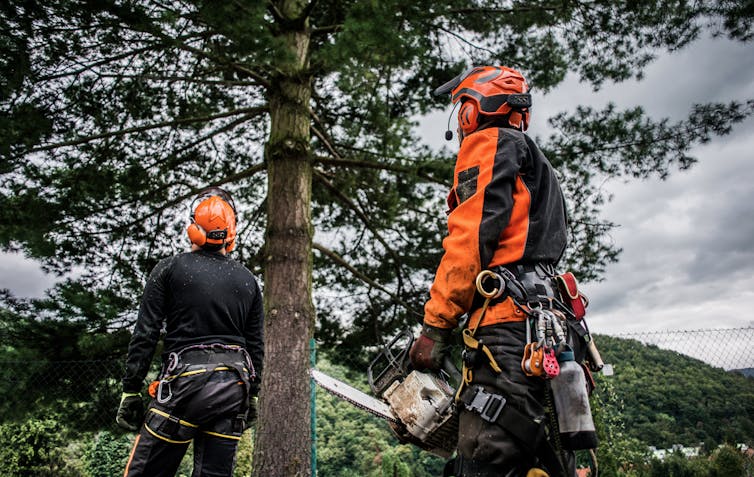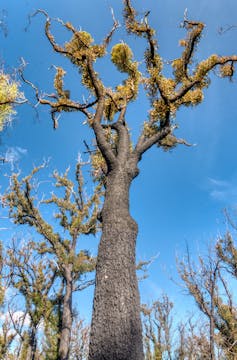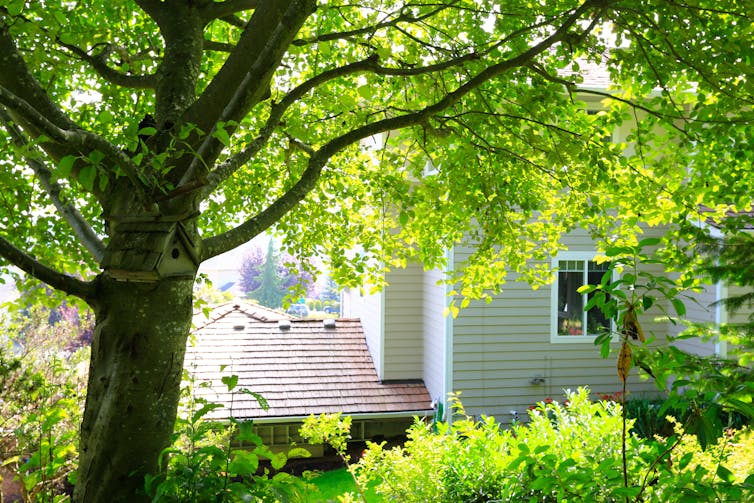By Gregory Moore, The University of Melbourne
Have you had a knock on the door or perhaps a card in your letterbox telling you the trees in your garden are dangerous and need urgent work? Maybe you’ve been a bit worried about the trees, which seem to be getting bigger each year, and think: “Well, it can’t do any harm […] can it?”.
Unfortunately, deciding to take action might cause harm to the trees or significant financial loss to you.
There are some serious scams in several states involving knock-on-the-door tree loppers who pressure elderly home owners for work. This has led to petitions from victims and some local governments seeking to have tree loppers licensed. Some of these cases involve thousands of dollars and very poor quality work with potentially dangerous outcomes.
As a tree scientist who works with urban trees, I can assure you some large, old trees are well worth leaving alone, even you find them annoying sometimes. So if you are going to prune trees in your garden, especially healthy old trees, make sure you do it well.
Hiring a good arborist
Trees are large and sophisticated organisms, and people who work on them need to be qualified so they know how trees will respond to their actions. Otherwise, there’s a risk that works done on trees could actually make its structure unsound and unsafe.
There are many well-trained arborists in most Australian states who can work on your trees.
But how do you judge the good from the bad? Here are a few tips on what to look for in employing a good arborist.
First, a good arborist will have TAFE or university qualifications in arboriculture (at least a certificate Level 4), and substantial public liability insurance cover (at least A$10 million and most will have a A$20 million policy). Be sure to check your home insurance policy as tree work may not be covered, and if something goes seriously wrong it can be very costly.
Read more: What adds value to your house? How to decide between renovating and selling
Second, trained arborists won’t work on large trees or off the ground on their own. There will always be a crew of at least two, regardless of whether they’re using travel towers or ropes and harnesses to access a tree. They’ll also explain exactly what they propose doing to your tree and why.
And finally, most good arborists won’t describe themselves as tree loppers and will prune rather than lop your trees. Pruning is a targeted approach to tree management, while lopping is a wholesale removal of branches and foliage that can lead to problems in the months and years ahead.

So where can things go wrong? It’s not uncommon for elderly people to become worried about big, old trees that are perfectly safe, then have them removed, and then find their property value has significantly declined at a time when they need assets most.
The unnecessary removal of a large old tree destroys an asset that has taken years of care. Its removal may seriously reduce your property value by up to 5% or $10,000 if the tree is a significant component of your garden.
When you feel ‘treegret’
Indiscriminately lopping a tree’s canopy — which can leave little or no foliage and greatly reduces branching — may seem like a good way to eliminate the risk of shedding leaves, fruits, and dropping limbs.

But if it’s done to a healthy tree with a sound structure, you can create the very problem you were seeking to avoid: greater shedding and the development of a dangerous canopy.
This is because, after severe lopping, many trees respond by producing lots of new shoots, called epicormic shoots. You may have seen these growing after fires. Epicormic shoots can be weakly attached to the trunk or larger branches of the tree in their early years and, if they’re not managed properly, the heavier shoots can shed substantially.
In any case, is the tree really so bad?
Many people are very aware of the things that annoy them about their trees — dropping leaves, flowers and fruits, blocked gutters, and even cracked fences and paths.
They often forget or are unaware of the benefits these same trees provide. This includes shade in summer, moderating strong winds, which protects their roofs during storms, or the value of tree roots systems in stabilising soil on steep house blocks.
You may only become aware of the value of these services after the tree has been removed – you acted in haste, but may regret the loss over the many years it takes to grow a replacement tree. This is treegret!

Ask the right questions
You can be doing the right thing when you decide to get work done that improves the appearance, structure, or heath of a valuable old tree in your garden.
A branch may be growing too close to your home, a low branch may block access for vehicles or pedestrians, or you may have dead or diseased limbs posing a risk to the tree and a hazard to people.
Read more: Solar panel fire season is all year round and it’s getting more intense in Australia
But next time there’s a knock at your door and you have the chance to greet a tree lopper, don’t forget to ask them if they’re qualified. Ask how large their public liability insurance policy is and what size crew will be working on your job.
And then ask them exactly what they propose to do to your tree.
I have asked all of these questions and been told of qualifications I know don’t exist, come from institutions that don’t train arborists, and of plans to lop or top the trees that I know will leave them less safe.
Gregory Moore, Doctor of Botany, The University of Melbourne
This article is republished from The Conversation under a Creative Commons license. Read the original article.
READ MORE


